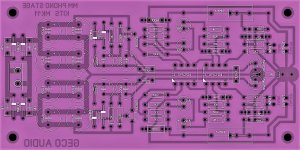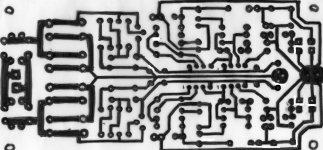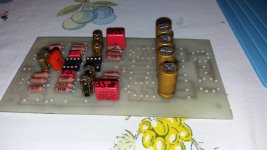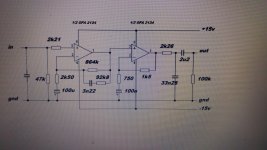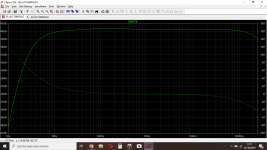Hi. I continue with my DIY obsession with the preparation of phono preamps.
Over the years I have made P06; VSPS300; VSPS400; Muffsy and I bought the components to make Richard's Emerald.
Searching the web, I found a forum where a phono pre based on the Rod Elliott P06 circuit (2 stages, the first active and second passive) has been made, with a different PCB than the original.
It occurred to me to use on that PCB to make the phono pre, with the values that are in Emerald, but respecting the design of active and second passive first stage (the opposite of Emerald).
I have been careful to measure the values of the components to match both channels.
I have used Dale 1% metal film resistors and Wima MKP capacitors, chosen for an accuracy of less than 3%.
The transformer I own is a 50VA toroidal transformer with Shottky diodes BYV27-150.
Handmade PCB with acetone toner transfer method.
Result: it is difficult to decide whether it is better or not with respect to those mentioned above.
Each of them has its own imprint.
But you can say that it is very very good. Of course, the Pro Ject Phono Box is ruined; to the pre phono that the Marantz PM6006 owns and perhaps better than Rotel RQ 970BX.
Over the years I have made P06; VSPS300; VSPS400; Muffsy and I bought the components to make Richard's Emerald.
Searching the web, I found a forum where a phono pre based on the Rod Elliott P06 circuit (2 stages, the first active and second passive) has been made, with a different PCB than the original.
It occurred to me to use on that PCB to make the phono pre, with the values that are in Emerald, but respecting the design of active and second passive first stage (the opposite of Emerald).
I have been careful to measure the values of the components to match both channels.
I have used Dale 1% metal film resistors and Wima MKP capacitors, chosen for an accuracy of less than 3%.
The transformer I own is a 50VA toroidal transformer with Shottky diodes BYV27-150.
Handmade PCB with acetone toner transfer method.
Result: it is difficult to decide whether it is better or not with respect to those mentioned above.
Each of them has its own imprint.
But you can say that it is very very good. Of course, the Pro Ject Phono Box is ruined; to the pre phono that the Marantz PM6006 owns and perhaps better than Rotel RQ 970BX.
Attachments
Last edited:
Hi. I have no arguments to discuss this point.
I am a doctor by profession and enthusiast of audio and DIY.
All the circuits I have made are based on other people's designs. I just take them and perform. I even do the PCBs by hand.
But with respect to the inputs near the outputs, they were already on the PCB that I copied from GECO phono stage.
Richard does the same with his phono stages (phonoclone; VSPS; Emerald), the inputs are next to the outputs.
I am a doctor by profession and enthusiast of audio and DIY.
All the circuits I have made are based on other people's designs. I just take them and perform. I even do the PCBs by hand.
But with respect to the inputs near the outputs, they were already on the PCB that I copied from GECO phono stage.
Richard does the same with his phono stages (phonoclone; VSPS; Emerald), the inputs are next to the outputs.
And unnecessary noise generator?A non-inerting-input stopper
The 2k2 resistor on the input is for two reasons:
1) It helps protect the opamp inputs againstn an ESD strike (static electricity).
2) It forms a low pass filter with the input capacitance from the opamp to help reduce radio interference. Opamp input stages can have parasitic PN junctions that tend to demodulate radio signals by accident, outside of their normal operating regions.
jh
1) It helps protect the opamp inputs againstn an ESD strike (static electricity).
2) It forms a low pass filter with the input capacitance from the opamp to help reduce radio interference. Opamp input stages can have parasitic PN junctions that tend to demodulate radio signals by accident, outside of their normal operating regions.
jh
- Status
- This old topic is closed. If you want to reopen this topic, contact a moderator using the "Report Post" button.
- Home
- Source & Line
- Analogue Source
- Phono pre madness
